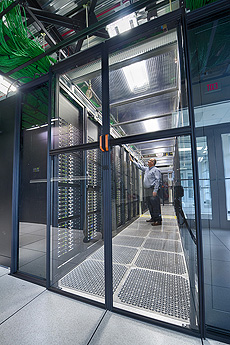Keeping cool at Grid Computing Center
 |
Grid Computing Center Manager Adam Walters oversees the installation of GCC's new sliding doors and top panels, which replaced the facility's plastic curtains. The new fixtures are better at keeping cold air in the designated cold aisles, helping save energy. Photo: Reidar Hahn
|
Aside from the accelerators, nothing at Fermilab uses as much energy as its three computing centers.
That's why the laboratory's computing staff is constantly searching for ways to increase energy efficiency. The latest of these ideas is, if you'll pardon the expression, a pretty cool one — workers are installing glass doors and plastic panels between server racks at the Grid Computing Center to keep the cold air in and to reduce the energy used to keep the equipment from overheating.
According to GCC Manager Adam Walters, for every megawatt of power the servers use processing data, it takes another half megawatt to keep them cool enough to operate. Step into the Grid Computing Center, and you'll be hit with a wave of sound — hundreds of fans running at once inside hundreds of servers on metal racks.
Those racks are arranged with hot aisles and cold aisles between them. Rather than keep the entire room at a frigid temperature, the cold aisles direct colder air where it's needed most — into the server air inlets — and the hot aisles give the warmth the servers generate somewhere to go. Traditionally, the cold air has been kept in using plastic curtains, but the new sliding doors and top panels will allow less of it to escape, Walters said.
"This should allow us to run fewer fans and run the ones that are on more slowly," Walters said. "That will enable us to use less electricity."
It will also help equalize the temperatures in the cold aisles, which will allow for better control. Additionally, the plastic panels over the top of the aisles will shrink under extreme heat and fall away, clearing the way for the sprinkler systems in the event of a fire.
Walters said this idea has been talked about for roughly five years, and computing staff visited other institutions to see how it has been implemented. The project involves the installation of 16 sets of sliding doors and plastic panels between server racks at a cost of $90,000. The work is under way and should be complete by early November. If it saves a significant amount of money, Walters said, the idea may expand to the Feynman and Lattice computing centers.
This is just the latest in a line of energy-saving practices at Grid Computing Center, practices that have led to the U.S. Environmental Protection Agency awarding its Energy Star status to the center for three years running. Walters said that status means that GCC is in the top 25 percent of data centers in the country when it comes to energy efficiency.
Cutting down on energy consumption is part of the culture at the Grid Computing Center, Walters said, and the staff will continue to seek out new ideas.
"Efficiency is important because we use a lot of energy out here," Walters said. "We're saving the lab money, and that's money that can be used for other mission-critical projects."
—Andre Salles
|